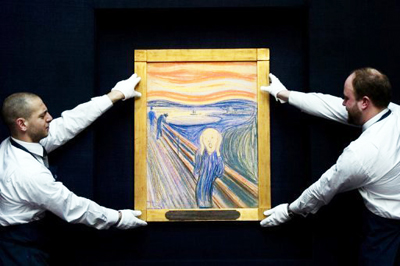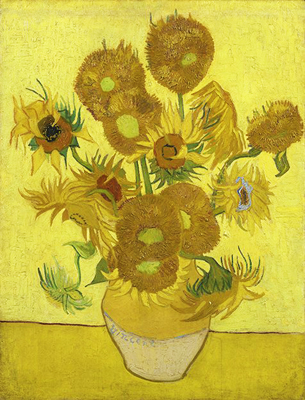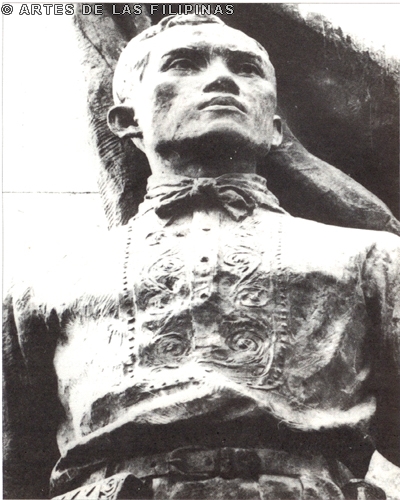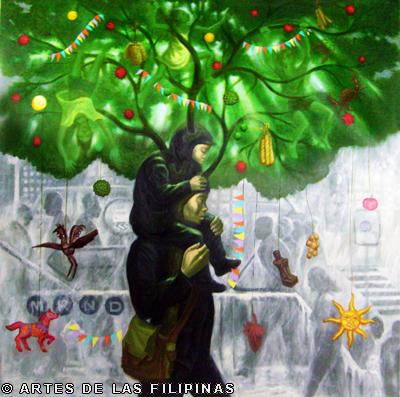
Mia Herbosa at the L’arc en Ciel
The Mastery of Mia Herbosa
by: Christiane de la Paz
July-August 2010–Mia Ongpin Herbosa has a unique standing in the history of Philippine art. Coming from the bloodline of Jose Rizal and Damian Domingo, she proves with her talent in painting and erudition that the apple has not fallen far from her forefathers’ trees. Her career commenced after graduating from the Ateneo de Manila University in 1991 but it was in the Art Students League in New York that she spent some of her most productive years, learning a range of theoretical and technical skills, bagging major and important student awards and producing some of her more memorable works. Whether in her portraits, nudes or still lifes, Mia Herbosa’s engagement in the act of painting is becoming more discernible, privileging inventiveness over grand statements. In the course of her young and promising career, her art has won her respect, increased recognition and a substantial following, making her one of the more important artists of her generation. In this July interview, Mia talks about her schooling and early influences, her training in the Art Students League, her first job, her family life and how living and Manila and New York have helped her in more ways than one.

After Innes
After graduating from Ateneo de Manila in 1991, how was your life like during this period?
Just beginning. I had taken private lessons with my first mentor, Henry Braulio in the Madrigal Center in Alabang since I was seventeen. I loved to do art in my spare time, felt I needed more since Ateneo didn’t have a pure fine arts course back then, just some electives. I always did well in art, always had fun and was always encouraged to pursue it seriously by all my art teachers.
Is there a Fine Arts degree in Ateneo?
None. I took up Interdisciplinary Studies which allowed the most free electives to choose fine arts subjects and related creative endeavors.

Bethesda Foundation
What made you decide to pursue fine arts?
Fine Arts has always been my first choice. When I was studying in Ateneo, one of my teachers was a Jesuit priest named Rene Javellana. He knew I wanted to pursue fine arts abroad, either in Paris or in New York. He showed me a brochure of the Art Students League in New York and he encouraged me to try it. He studied sculpture there for four years and he loved it and highly recommended it to me. The next years are history. I ended up studying there full-time for over ten years as I kept enrolling every time I am back in the city. Looking back, I felt God led me there. The school taught me everything I know in art today and it gave me its top prize while I studied there. It’s like the Art Students League and I have a love affair.
So Fine Arts was a second degree?
I don’t think you could call it my second degree as the Art Student League was not that kind of school. What I mean is, it is not a college, it is not academia, it is an art school for artists. It offered four year full-time courses in Painting, Printmaking and Sculpture among many others and this is what I went for as a foreign student. I did all three, a total of twelve years.

Chinese Screen
Did you not consider studying fine arts here?
I did. I was in Interior Design for about a month in UP, wondering if I should shift into Fine Arts there but that didn’t happen. A series of events during that first month of college in 1987 found me in Ateneo in a month. I don’t think I was meant to study there for some reason. Something wasn’t right. It was one thing after another. But all my friends who studied there loved it. I look back now and think all things happened for a reason and that there are no accidents. Ateneo was a very good school for me. Even if it didn’t have a Fine Arts program, many of the teachers there were of good caliber and they made me think and dig deep into my idea of why I was alive, or what I was born for, or what I really wanted to do.
What made you decide to study in New York instead of Paris?
My boyfriend of seven years then was in New Jersey. His family took me in and I could study in New York while commuting from New Jersey for the first couple of years before I moved into my Manhattan apartment in 1995.

Copper with Apples
Is Art Students League the best school to study Fine Arts?
If you want to be an artist, I would think it is one of the best, for sure. It suited my temperament to a tee.
What are some of your favorite courses in the League?
I always loved the traditional painting classes where you paint from life, doing model or still life in the best of lighting conditions- natural northern light from high skylights with tempered glass that allowed the light to filter in beautifully. The courses are dominated by a teacher’s style so you chose the class based on the teacher’s work, really. Art is a visual communication, like learning to speak a different language.

Bowl of Fruits
Do your professors return the plates you submit for class? What do you do with them?
Yes, of course they return them. Almost all of my works are gone. I have only like ten major ones from like almost seven hundred, I think.
What is the most memorable painting you have done during this period?
Aviva stands out. The year 2000 was amazing for me. There are lots of synchronicities.

Aviva
Who are you contemporaries in the League?
Gabriella Delloso, Michael Grimaldi, Sarah Lamb, Toots Magsino, Yee Mee Lee, Mark Gonzales, Yuka Imata, Bennet Iglesias, Gregory Halili, Jennifer Li, Nicholas Oberling, Shoichi Akutsu, Robin Smith and many more.
Do you have Filipino students in the League?
Yes, many go in and out but Toots Magsino has been there a long time and there is also a teacher there, Mariano del Rosario, who teaches collage and assemblage, sometimes his works have Tagalog words in them.

Little Flowers
Who are your Filipino contemporaries?
I’m not sure but I know I am about the same age as Jonathan Olazo.
Have you worked with Jonathan Olazo in the past?
No, but we are friendly and we met when I was first starting out in 1995.

Just Garlics and Onions
After graduating, what was the first job you applied for?
I wanted to work in the animation department of DPSI, the Apple distributors here in Manila in 1991, but they put me in sales. After about five months, I was on a plane to New York City to study art.
After this stint, did you have another job?
Yes. I had a lot of jobs here and there. I was a cashier in New Jersey, a switchboard operator at the Art Student’s League and a gallery attendant there, too. I also worked at the art department of an advertising firm named Avellana and Associates in 1992. Then my last job was at a computer help desk for UNICEF in New York in the late 1990s. The balance was good for me when I took these jobs. The stability of a regular income felt good. These were jobs I did in my time away from school like mornings or evenings after school or in the summer. It was helpful when art was taking over my breathing, eating and sleeping life. Art has a way of doing this.

Homage to van Gogh
Why did you not consider working in corporations?
I did work for UNICEF for about a year. My temperament was always to work by myself and to discover things on my own. I find it hard to work in a corporation this way. I always had a particular way of seeing things and this was what I wanted to develop and nurture. I really felt a huge need to do this.
You first entered the art scene in 1995, what is the status of the Philippine art scene during those time?
I was never very familiar with the art scene up to now as I was mostly in New York. I would come home sporadically to have shows. I joined group shows every now and then, when they would invite me. I just kind of plunged into the scene after having been painting in New York for about four years fulltime then I thought it was time to have a show in Manila so people would be familiar with my art, my journey.

The Tea Party
How about the art scene in New York, what was it like when you were starting out?
My friends here were also starting out and it was all so exciting. Frank Mason, Ron Sherr, Gregg Kreutz, all my teachers and the others at the League were masters of their mediums and were having very successful shows. We had nothing but utmost respect for the artist’s life. The knowledge they constantly tried to impart was precious and so was the example of their lives. The education was all-around. The shows in New York were always exciting and worthwhile, exhilarating and exciting.
How do you situate your works with the other works of foreign artists?
I became a junior scholarship member of the famous Salmagundi Club and won many prizes there. I felt this was my training ground for learning the discipline of having exhibitions, creating works and making sure deadlines were met, and being true to my vision all the while.

Still Life with Silver
In the New York art scene, how do you apply to have a show in a particular gallery? What are some of the top gallery names to exhibit?
Most of the time you show your portfolio or the works you have available to show and sell. That’s about it, Most of them have a fee. My favorite galleries to go see shows are The Forum, the Eleanor Ettinger Gallery, Arcadia, Marlborough Gallery. I would also frequent the Philippine Consulate, the place were most Filipinos show as they are right at midtown on Fifth Avenue.
Have you ever been turned down to have a show in any galleries in New York?
Actually, I was very careful, I only ventured so far. My time was so busy in school. I could only exhibit at selected exhibitions where there was an invitation to show or it was juried like at the Salmagundi or Ward-Nasse Gallery, a coop gallery in SoHo that was very nice to me.

Phoenix Jar
Does your audience know that you are a Filipino artist? Do you make an effort to let them know? Or does it even matter?
They always know. I almost always have shows when I am invited or they know of me already. If not, then I sell directly from home.
How does exhibiting in Manila differ from exhibiting in New York?
So different but it’s always personal. I have so many people to help me here in Manila from the driver to the workers in the Gallery. I am much more taken care of in Manila. In New York, it’s harder. My husband Paul and I or whoever else I was showing with had to do almost everything ourselves. I find it similar to living in both places. In New York, most everything for me was a do-it yourself job and this toughens you up. It makes you resilient and strengthens your will. In Manila, you can focus on the details and can relax a bit. The community and religious sentiment makes things much friendlier and opening nights warm and cozy. I remember showing in a winter storm once. It was incredible. A lot of people came for the opening more than what we expected. But after all the excitement, we had to walk home in the blizzard for like ten long city blocks after the show was done as there were no taxis around. That was like midnight and we were in formal attire. Whew, what you do for art!

The Little Red Chair
Where do you shop for your art materials in New York?
New York Central, Pearl Arts and Crafts, Utrecht, Art Students League Store.
Which paint brands are you most comfortable using?
I love Old Holland because they last a very long time and they are incredibly powerful especially its cadmium red light but others will do like Winsor Newton, Utrecht brand. Blocx is also another favorite of mine but some colors are hard to find.
What are some of the most interesting museums you have visited in New York that are not popular among tourists?
The Hispanic Society is a gem and Jewish Museum sometimes has wonderful special shows.

Three Hats
But personally, which museum made the most impression on you?
I have always loved the Met and will always go there to be inspired. Across the world, I loved the Gemaldegalerie in Berlin, Mauritshuis in the Hague and the Alte Pinakoteka in Munich. The Musee D’Orsay is another one I always visit as well as Rodin’s home in Paris. I was very much touched by the little village Auvers in France where van Gogh killed himself and painted his final pieces. I fell in love with Breughels at the Kunsthistorisches in Vienna. The elegance of the Uffizi also enthralls me every time.
Have you visited the National Museum in Manila? How does our museum compare to what you have seen and studied abroad?
Yes, I think they are even devoting a wing to my great great grandfather, Alfonso Ongpin, who was one of the largest collectors of Lunas and Hidalgos in his time. I love what they did with the Luna room but really, we have much much more to show don’t we? There is still so much we can do. It should be an educational experience for the young and old. Most of my Titas (aunts) are members of the Museum Foundation and are working towards improving it.

Portal in my Mind
Tell me about your first exhibit. What was the turn-out and review?
My first solo show was called “Capturing the Spirit; Beyond the Paintbrush.” It was mostly portraits I had done in New York and some still lifes. I had thirty works, they were sold out. This was in July 1995 at the Ayala Museum, the old one. That show blew my mind and opened doors to a whole new world for me. I never met so many encouraging people before. It was an amazing experience.
What did you do with the income you generated from the sales?
As always, I use the income to live and continue my work.

Reminiscing
What was the first gallery here in the Philippines that carried your works?
George Sison Gallery of Fine Arts in Chino Roces Avenue. That was where I had my second show the year after. It was also sold out during the opening night.
Where do you draw ideas for your works?
My ideas are always from my life. I paint my life. I try to show people the stages of development in one single person’s life – in my case, me, whether I am in New York or Manila or traveling elsewhere. When my daughter, Lana, was born, I was filled with thoughts of motherhood. Many of my still lifes had her favorite things in them, things that filled my everyday life. When I was a serious art student, my work was very somber and this was reflected in my works as well. I have always been interested on how painting and art becomes a vehicle of communication and that it is richer than words in many ways. Now I live in Laguna, again another change comes over me with seeing all the sunlight, nature, birds and rice fields around me.

Natalie
Did you ever find yourself in a situation when your idea for your own exhibit has been executed by another artist?
Never except when I’m invited to a theme show like “Homage to the Masters” at the Metropolitan Museum in 2002.
When you are in the process of working, who exactly is the viewer you have in mind?
All people living and those who have passed away, those born and yet to be born, old and young, everyone, really.

Pretty
Are you a member of any artist’s group?
The Art Students’ League, Society of Philippine American Artists, L’arcenciel Atelier Group.
What do you think are the advantages and disadvantages of being part of an artist’s group?
There is a synergy when artists get together for art. I learn more and also show in different venues. I also make friends with people with similar interests. The disadvantage of this is that sometimes I am unable to participate as much as others, due to my own work and family schedule.

Kia
Have you ever won any important awards?
Yes, several from the Salmagundi Club in New York City. It’s the oldest art club in Manhattan housed in a beautiful old limestone building on Fifth Avenue. Being part of their group was a very nice experience. Between the years of 1996 and 2000 they gave me five awards, one for 1st place at the Junior Scholarship Exhibit. I was truly honored. But I think nothing compares to the McDowell Travel Grant Prize that the Art Students League gave me in 2000. It was the highest honor a student could get. The whole school vies for it- all styles of painting, sculpture and drawing. They bring in judges from all over the US to choose winners. They give you funds for a four month journey to Europe and then the school gives you a show after a year, to show your work. That was one of the most amazing dreams that came true for me. I never thought I would win, I think I was in heaven the whole time since. The League also gave me a Merit Scholarship in 1996 and a couple Red Dots, Best in Show and Blue Dots as Honorable Mentions. Through the years they gave me work, and study grants too that allowed one to work to pay for classes through the year. It’s a great school. I wish we had one like it here.
Do you think awards help make a painter become commercially recognized?
Definitely especially if it’s from a credible source, nothing could be better.
Whose style are you drawn to painting during your student years?
Many. I have always been in love with the old masters – I guess all the big names. I was sketching Michelangelo in the library in high school, drawing da Vinci and just mesmerized by the colors of Raphael. Botticelli is the best decorative painter, really sublime, but they all are. I love the Northern painters best, Rembrandt, Vermeer, Van Eyck, Memling but my personal favorite is Hans Holbein the Younger. Then I also love the impressionists like Degas. I always feel personally for Van Gogh, also Lautrec. Among the Americans I love Sargent, Whistler, Cassatt and Eakins. Among the Russian Impressionists, Valentin Serov for me is unbeatable. There are just too many to mention, I could spend my whole life in museums. I also loved the landscapes of George Inness. There also many incredible artists alive today.

Hands Behind the Back
Which local painters had an influence on your art?
Juan Luna, Victorio Edades, Felix Hidalgo and Vicente Manansala.
Can you tell me a bit of your family and educational background? Where are the Herbosas from?
I went to De La Salle Zobel for grade school and high school. Since I was born my parents have told me of two illustrious bloodlines connecting. My dad’s grandfather was Estanislao Herbosa who was Rizal’s`favorite nephew, son of his sister Lucia. On my mother’s side we descended from Damian Domingo, the first Filipino painter. Her great grandfather was Roman Ongpin for whom Ongpin Street in Chinatown was named. His statue is there in front of Binondo Church. Her grandfather was Don Alfonso Ongpin, who also has a huge Rizaliana collection aside from his paintings. They owned El “82 in Binondo, Manila which was the first Filipino hardware and art store, as I was told.

Lady with Hat
Are you the only artist in your family? What do your siblings do for a living?
My mom also paints and is also very successful as a teacher and artist. I only have one brother. He is a banker now. I remember losing to him in a drawing contest when I was about seven. It was about what you wanted to be when you grew up. He drew a race car; I drew a teacher. I always knew I wanted to impart something.
How did you become interested in art at a young age?
Alfonso’s collections decorated my Lolo’s (grandfather) walls. My mom’s first job was as an art teacher. She used to make us pose for her. At seven, she made me and my friends take painting lessons from my Lola Doni Ongpin, a sister of Alfonso, who was our family painter. She was already old, maybe seventy then. Art was fun and accessible as well as beautiful. My mom also encouraged us to always keep our hands busy. At school, the teachers applauded my work. It was all so friendly and welcoming for me.

Elaine at Sixty
You mentioned you have a family of your own, is your husband an artist like you?
No. My husband is Paul Agoncillo, a chef. He works at Battery Park in New York City and is also the reason why I go back and forth so much. We met in high school. We have a daughter now, Lana, who is seven.

Ancestor
With a family to care and a bright future ahead of you, how do you manage your schedule?
I am in New York from March to May sometimes in October too for autumn. Most of my shows are in Manila especially now that my daughter is studying here.

Legacy
Who handles the business side of your profession?
My mother manages me and the other artists in her gallery, L’Arc en Ciel.

Little Chinese Model
Are there Filipino artists represented in this gallery?
Ditas Dominguez, Pilar Quiroz, Margie Villongco, Miguel Buhay, Carla Kim, Stella Kim and so many more. They are almost all Filipino.

Mutya
Do you have an idea of the profile of collectors who buy your works?
Most people who buy my work tend to be serious collectors who love art.

Ruby Turban
What about your early collectors?
I’ve always been thankful to the Eduques, Garcias, Montillas, Robby Santos, the Hilados and the Herbosas and Ongpins. I really don’t feel like it would be right to name people though because many are quite private, no matter how grateful I may be. In New York I am in the collection of the Museum of the City of New York, the New York Library and the Art Students’ League.

Mr. Wilson
What has been the best compliment said about you or your work?
Someone once told someone that I was a National Treasure. I don’t think anything has topped that for me. I have always been grateful for God’s gifts.

The Wise Man
What have you been criticized of?
The high price that my works command because I always felt they were priced fairly well though in comparison to my contemporaries in New York who sell at much higher prices now. I have always priced my works fairly to live my life. I’ve actually been blessed that for every person who finds the prices high, another one will come and be happy to buy and put in his home with no problem. It just makes me feel that there is a right time and place for everyone and everything. The most important thing is to be honest with oneself and be happy with one’s choices.

Curly Tops
What can you say is your clear talent in painting?
Boy, I can’t be sure. Many people say my work is very sensitive. I mean this was from day one. I know I am very sensitive. Others say my painting is clear, has a clear quality to it. Some say it is ethereal, I’m not sure what my clear talent is but what I do know is that I can be very very patient and strong-willed. And honesty in vision means a great deal to me. I think this is necessary in art–oh so necessary.

In The Studio
Let’s say that your art did not work well to your advantage, do you have a back up profession?
Teaching art always seemed to be a good back up plan for me, it still is. I would always like to paint and teach. I think this is how you grow. It is what I witnessed at the League.

Life in a Still Life
Do you think that your works will hold a place in the history of American art?
That I don’t know but I know it will in the history of the Art Students’ League and that makes me so incredibly happy.

Clown Brothers
How about in Philippine art?
I hope so. I always wanted to be a positive contribution in whatever thing I pursued. All I know is that I always give my best effort. I’m already happy with that. Then, I will let the wheels of time and destiny do what they will.

Andrea and Tinker











